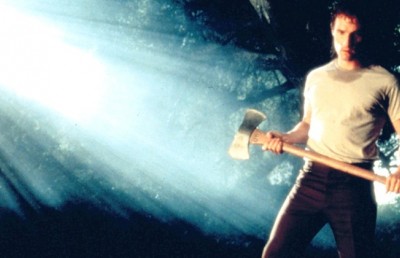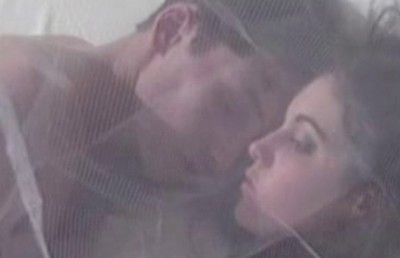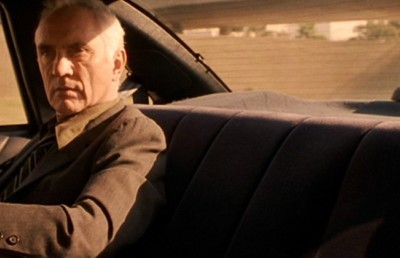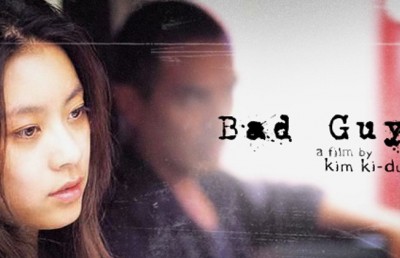Sátántangó
And then there was Darkness
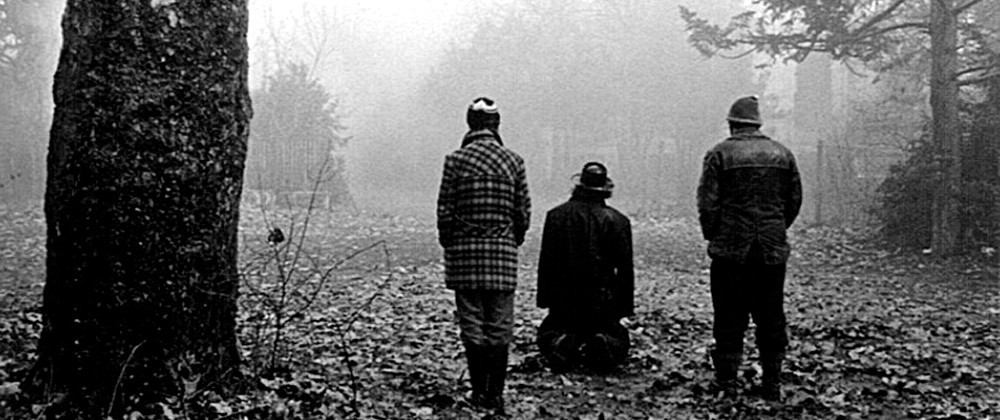
In the last scene/shot of Béla Tarr’s Sátántangó an enigmatic doctor character, whose hulking body and slumbering movement is not unlike the whale in Tarr’s Werckmeister Harmóniák, slowly boards up the sole window of his living quarters. The camera films his action from behind his desk, which is set in front of the window. Earlier in the film, much earlier, about seven hours earlier, this very place marks an important temporal awakening in the film. But now we sense that the doctor, who leaves his room only when he has run out of fruit brandy, has come to the end of a long journey. In a prior scene the camera follows his lumbering body as he walks along a long road, veers off to a church ruin atop a hill, climbs a set of stairs, and finally walks into the center of the church. The camera continues to dolly forward to an extreme close-up of the source of the sound the doctor has been walking toward: an old man rhythmically clanging a steel rod in lieu of the missing church bell, while repeatedly yelling “The Turks are coming, the Turks are coming.” Who is this old man? Where are the Turks? Is the old man a lost relic of the past? The moment makes no sense, but somehow it evokes an ominous and portentous atmosphere which is a perfect culmination of seven plus hours of similar tension-filled ‘senseless’ moments. The next shot tracks back along the same dirt road as the doctor returns to his home. We are back to the window. The encounter with the bell ringer seems to have touched the doctor. Now not only does he not want to leave his home, but he needs to shut himself off completely from the forbidding outside world. One by one he nails four horizontal planks, each one lessening the sunlight until he nails the final plank in complete darkness. Rather than the proverbial ending evoking the Biblical “And then there was light,” Tarr offers us the opposite. The effect is at once literal and metaphoric. The final image leaves us in a metaphysical void. In fact it is the closest any film has come to providing us with an image of metaphysics. One recalls the famous cynical Positivist definition of metaphysics as akin to looking for a non-existent black cat in a darkened room. And strangely enough, a cat plays an important part earlier in the film, as the helpless victim of a tragically pained little girl.
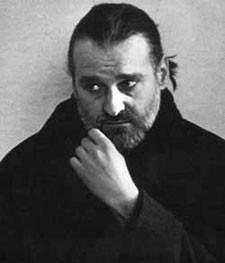
Béla Tarr
Sátántangó is the most emotionally overwhelming cinematic experiences I’ve had since Sokurov’s Mother and Son. The actual emotions may be different, but the sensation of being touched in both body and mind is the same. As I think back at both experiences, with Sátántangó being much more recent, I remember them both as a singular block of time, even though one is 450 minutes and the other 72 minutes. The best way to describe it is that the sensation I felt in my body from head to feet at the end of both films was identical: a calm, tingling numbness that comes after an exhilarating, sustained moment. And, strange as it may seem, one film did not “feel” longer than the other. But what is untrue about this statement is that the mammoth length of Sátántangó is undoubtedly an integral part of its aesthetic conquest: the sense of having embarked on and concluded a journey. The reason why a film that is some 380 minutes shorter can still produce a similar effect is tied to the question of style. Both films evoke a rapturous mise en scene through extended long takes with slow or repetitive action, textured soundscapes, and heightened (though contrasting) natural landscapes. But the question of length is still inescapable. Sátántangó belongs to that rare breed of film which attains its aesthetic power largely through its imposing length (another such film that comes to mind is Eureka). This may seem to contradict the previous statement, but the contradiction is a result of a paradox that exists in the nature of time. When it comes to subjective time there is no clock. An event of interminable length may not be temporally perceived as such. One of the world’s most esteemed scholars on the philosophy of time, J.T. Fraser, points out this paradox when he writes “That we usually experience a high-intensity event as having no time or sometimes as lasting an eternity is one of the paradoxes of subjective time.” The same can hold true for a “low-intensity” event. The point being that what we experience shapes our perception of time so much that when we arrive at the end of a film such as Sátántangó, we no longer think of it as an event that began at 2:00pm and ended at 10:10pm (as it was for myself with the two short intervals), but simply as an event of a singular duration.
The Sátántangó “event” is an epic about the interlinking lives of a group of eight or so people living in a small rural town. The people spend their time getting drunk in the local pub (Tarr loves these rural, home style pubs) while waiting for a false messiah, a Christ-like looking man named Irimias who goes from town to town with his two sidekicks (the three wise men) deceiving the poor and downtrodden to sacrifice a years salary for his recipe of instant freedom and salvation. He collects the money and tells them to leave their homes and meet him the next morning at an abandoned villa which will serve as their salvation abode. When they arrive the next morning and their messiah is not there they turn on each other. Just when we think they’ve been had, the messiah shows up, only to prolong the deception by telling them they must postpone their celestial commune until the time is right, and sends them off to live in different cities. What is interesting about the messiah figure is that although he is an obvious fraud, there is a modicum of truth in what he is doing. His role becomes that of catalyst for each person’s own self loathing or self awareness. He is equal part cult leader and equal part inspirational leader a la Tony Robbins, trying to get each person to recognize their own inner power.
We experience most of the characters in groups interacting with each other. This is played out comically in the film’s funniest scene, an extended dance in the pub. The camera records this dance of the absurd with a mainly static long take from a slightly high angle. Everyone is completely piss drunk. In the middle of the action is the central couple, a forty-something married woman and an admirer, who tussle and push each other as much as dance. The woman’s disinterested husband walks across the dance floor balancing a long cheese bun on his forehead. A lone lady sits quietly at the far left of the frame. A bearded man noted for his extremely repetitive bar stool monologues, which no seems to one take heed of, lies on a bench rhythmically stomping his heel on the floor. (One can’t but think that this man’s annoyingly repetitive monologues are a comical reflexive gesture on Tarr’s part for his excessively long takes, especially the one moment where the drunk repeatedly bellows “There I was, plodding, plodding, and plodding along”!).
As noted, most of the characters are observed in groups, but two characters, the aforementioned doctor and the ten year old girl who kills the cat and then commits suicide, are seen almost always in isolation. One of the few moments of human interaction is when their paths briefly cross each other outside the pub. Because of their isolation these two characters become, in a sense, the most tragic. The girl, who is the only child we see in a town populated by drunkards and adulterers, kills the only thing she has power over: her cat and then herself (she swallows the same rat poison she gave to her cat). The doctor spends his time at his desk looking out his window at the passing world around him, writing copiously into small high school notebooks, each devoted to a particular person. The doctor is the film’s most fascinating character, rich in thematic resonance. His situation recalls Plato’s famous Allegory of the Cave. The doctor’s understanding of reality is restricted to the parameters of his window. When he leaves his “shadows” for the real world he returns and rejects the “real world” by literally blocking it out. He prefers blindness to the truth.
One can also see the doctor’s position as being akin to the director’s. Like Tarr’s plaintive long takes, the doctor watches the world from afar preferring to describe each minute detail rather than comment on or attempt to change its outcome. In an interview with Jonathan Rosenbaum Tarr expresses a similar attitude in his approach to his actors and his long take style: “If I have a long take, six minutes, I don’t say too much to the actors. I just say what is the situation. And I say, okay, shoot. They just develop something from their personalities, some deep things, because they have no instructions –they are just in the situation. You can see in their eyes how they are in….They cannot escape from the situation.” [1]
Also interesting from the perspective of temporality, along with Tarr’s staggeringly long takes, is the film’s narrative structure, which is what I call “surprise non-linearity.” As the film begins we watch events that are occurring in a forward, linear temporality (with minor ellipsis’ occurring in between certain shots). At a certain point we experience a sense of deja vu which shakes this temporal foundation: a scene which we have already scene repeats but from a different spatial and narrational point of view. In this case the moment occurs, as noted in the beginning, from the position of the doctor’s desk. In the film’s second scene we see a man who has slept with a married woman sneak out of the house when the husband returns home. The camera later cuts outside to an image of the adulterer hiding behind the corner of a house out of view of the husband, who is in the middle background of the shot looking out into the expanse. Forty or so minutes into the film we see this same mise en scene of the man hiding from the husband but from the doctor’s point of view, as he writes the event down in his notebook. This stuttering temporality occurs on several occasions. Offscreen contributor Randolph Jordan tells me that when he saw Béla Tarr present this film in Vancouver the director used the tango to explain the film’s temporal structure: two steps forward, one step back. One can also see the temporal structure as an echo of the film’s metaphorical use of the spider. Several of the film’s intertitles make reference to the spider, and the spider makes a physical appearance at the end of the long pub dance scene. In a long lateral tracking shot of the drunken revelers a spider can be briefly scene in the foreground of a shot spinning a web between two glasses. The voice-over tells us that the spider will be spinning its web around the objects, and around the people in the pub, echoing of course the messiah’s trap. The spiral-like shape of the spider web acts as an apt parallel to the film’s narrative temporality. This type of “surprise non-linearity” has become quite common in recent years. A list of films which use such a structure, to varying degrees and ends, includes Korean director Hong Sang-Joo’s The Power of Kangwon Province/Kangwondo Eui Him (1998) and Virgin Stripped Bare by her Naked Bachelors (2000), Mystery Train (jim Jarmusch, 1989), Pulp Fiction (Quentin Tarantino, 1995), Heaven (Scott Reynold, 1998), Before the Rain (Milcho Manchevski, 1994), and A Moment of Innocence (Mohsen Makhmalbaf, 1996).
Aiding and abetting this aforementioned notion of a singular duration is Tarr’s method of shooting exclusively in long take. I would say that about 90% of the film’s shots are at least one minute in length, and of those many are sequence shots which comprise the full length of a camera magazine (approximately 9-11 minutes). In fact Sátántangó gains much of its power from this unfettered camera stare. As the surrealists argued, if you stare at something long enough it becomes bizarre. On countless occasions Tarr’s unfettered camera stare achieves such an effect. This begins from the incredible opening shot, an eight minute long take of a herd of cows meandering in open ground. For the first few minutes the camera remains static, at a distance from the cows. The cows move about but appear contained by the borders of the still camera. From time to time a bull attempts to mount a cow. What will happen next? Our patience is rewarded when a lone bull leaves the herd and walks menacingly toward the camera. As if taking this as a cue, the remaining cows begin to move screen left, and the camera tracks left to follow them. Throughout this long take there is a sense of portentousness, a sense of an unseen presence or power. This mood is carried throughout the film. As it does throughout, the soundtrack helps immeasurably to sustain this mood. If memory serves me right, there is no generic music in the film. Instead Tarr employs a recurring distant drone comprised of drums, a gong, and a train whistle. In the case of the opening shot, this otherworldly ‘music’ is accompanied by natural sounds of the cows.
On many occasions the subject of Tarr’s long takes are the Hungarian plains themselves (the puszta), the former stomping grounds of another great Hungarian long take stylist, Miklos Jançso. This unfettered camera stare also has the effect of escalating drama, even when simply perusing the muddy puszta. The point I am about to make holds for a long list of directors whose sense of temporality and pacing is recognized as being much “slower” than the norm (to name a few, Kenji Mizoguchi, Carl Dreyer, Andrei Tarkovsky, Alexander Sokurov, Hou Hsaio-hsein, Tsing Ming-liang, and Theo Angelopoulos). Why is it that the excessively long takes in Sátántangó, many with little action, movement, or narrative development in any conventional sense, are still fascinating and riveting (setting aside, of course, questions of personal taste)? The answer rests in a distinction I will make between narrative drama and drama of the moment. Most films, both popular and art cinema, derive their drama from machinations of the plot and/or our involvement with the fate of characters. Drama is created by what Noel Carroll calls “erotetic narrative”: questions are posed in one scene and then answered in subsequent shots and scenes (either immediately or later on). Will the hero arrive in time to save the damsel in distress? Who is the murderer? What will become of the kidnapped child? Will the heroine score that new job? Drama arises out of the movement of the plot and story. In contrast to this are the (usually) long takes in Sátántangó where drama is achieved not by large concerns of the plot or story, but by the audience simply wondering what will happen in the very next moment?, or more specifically, when will something happen next?, or when will something different happen? For example, after the young girl has tortured and maimed her pet cat she forces the cat’s face continuously into a bowl of milk. She then leaves it alone and backs up a few yards behind the cat until her back rests up against a wall. The image of the little girl flat up against the wall is itself a wonderful metaphor for the girl’s tragically dead-end life. The camera remains static with little ‘action.’ The girl does not move, the cat is barely able to move its maimed body. But the drama comes from wondering what, if anything, will happen next. The poor cat, unable to move its legs, attempts to lift its head to and fro from the bowl. Will the cat survive or drown in the milk? Will the girl bounce on the cat, as she did countless times before? Will she run up to the cat and kick it like a ball (that was the thought running through my mind.) These are the minor dynamic potentialities that make this a dramatic moment.
Here are a few other instances of the “drama of the moment.” On the first night of their renunciation the messiah followers fall asleep together in a large room. The scene cuts to a slow dolly forward to an owl perched on a balcony. What does the presence of the owl mean? The shot cuts to a overhead ‘ceiling’ shot of one of the characters lying asleep in a fetal position. The camera begins to dolly slowly across the other sleeping people, eventually performing a 360 degree arc by returning to the first sleeper. But the shot continues again in the same arc, and again, and again, and again. The movement and the ground covered is so constant that it may just as well be the point of view of a slowly moving ceiling fan. [2] At some point we begin to wonder, will one of them wake up? Will the arc ever stop? Is this the point of view of a dreaming sleeper (a voice over tells us about the floating dream of one of the sleepers, Mrs. Schmidt)? The previous described dolly shot that follows the doctor into the ruined church leaves the doctor for a close-up of the shell shocked old man chiming his makeshift bell. The camera remains fixed on his face for several minutes. We begin to wonder, will he stop the bell ringing? Why is he doing this? How long has he been doing this? During the pub dance scene a similar effect is achieved by the repetitive nature of the action. Will the bearded man repeating the same annoying phrases over and over ever shut up? Why doesn’t someone tell him to shut up? Once the dance begins the players dance and play on repeatedly. The accordionist plays the same musical phrase over and over and over. When will this absurdity stop? When will the accordionist play something different? The film is full of long takes like these that put the emphasis on the moment by concentrating on the singular.
Another formal quality that goes along with the long takes in achieving this “drama of the moment” are varying rhythmical patterns that establish a constancy that envelopes us and heighten our sensitivity to change. In the majority of cases this rhythmical pattern is sonic: a ticking clock, a whirring fan, the drone of a refrigerator motor, or the constant patter of rain. In the noted scene of the 360 degree overhead tracking shot it is the camera movement itself which becomes a rhythmical pattern. The effect is that each long take achieves a certain materiality, a temporal denseness which helps to “escalate the drama of the moment.”
Although critics are eager to throw allegorical and political interpretations at Tarr’s films, he is adamantly opposed to such discourses (recalling Tarkovsky in this matter). Sátántangó is so vague that any such attempts to view the film as some form of political allegory of Hungarian or East European politics can only lead to forced generalities. Although the scene where Irimias tells a police officer that he has no intention whatsoever of ever working, surely evokes the post-Communist economic malaise. Instead, Sátántangó is best enjoyed for its powerful ‘moments’ of human misery. Which is why Jim Hoberman referred to Sátántangó as “a masterpiece of visionary miserablism.”3 Like in Werckmeister Harmóniák, the miserablism stems from human nature: people who place all their hope in false messiahs and then have nothing to fall back on but anger, despair, depression, drunkenness, debauchery, and suicide.
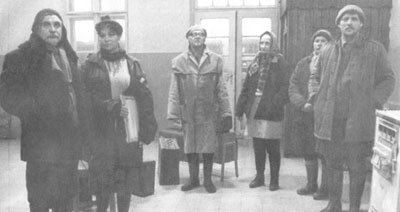
Waiting for the Messiah
But while the latter express well the state of humanity in Sátántangó (and Damnation (1987) and Werckmeister Harmóniák), Tarr contrasts this with formal beauty and brilliance. And amidst the misery Tarr injects his own particular brand of cruel humor and cynicism. This is in great evidence in the back to back traveling scenes with the messiah figure Isiriam and his two sidekicks. Just as Tarr has clearly established Isiriam as a charlatan there is a scene of him and his two companions walking along and coming to a clearing. The camera cuts to a frontal shot of the three men. All three men are looking upwards intently at whatever is in front of them. Isiriam looks especially moved by what he sees, and drops to his knees. Tarr underscores what seems like this religious vision with appropriate music. We finally cut to a group point of view shot of what they have been gazing at: a gorgeous ruin encircled by slowly lifting fog. The shot cuts to the three men with their backs to the camera as they walk away. We hear one of the companions coolly ask Isiriam: “Haven’t you ever seen fog before.” In the next shot the camera is positioned high overlooking a huge empty piazza, centered by a fountain and flanked by two huge Imperial styled buildings in the background. Many seconds into the shot a herd of about 20 horses come trotting into the piazza from the narrow road between the two buildings. They move toward the middle ground and trot around the fountain. The camera begins to crane down revealing the backs of the three travelers staring at the unusual appearance of the horses. As before, a potentially magic moment is undercut by a prosaic piece of dialogue: “It looks like the horses have escaped the slaughterhouse again!” Tarr’s disbelieving characters may not be impressed by what they see, but his audience will have quite a different account of the unique experience that is a Béla Tarr film.
Endnotes
1. “Falling Down, Walking, Destroying, Thinking: A Conversation Between Jonathan Rosenbaum and Béla Tarr” Cinémascope, Issue 8, September 2001, 23.
2. The latter is one of two specific nods to one of Tarr’s favorite Tarkovsky films Stalker. The other being a scene of the characters riding on an open air transport vehicle that recalls the trolley scene.
3. Week of October 3 – 9, 2001 This is where Tarr differs from the director who he is most often likened to, Andrei Tarkovsky. Although Tarr and Tarkovsky share some stylistic similarity (long takes, great attention to landscape and nature, use of black and white), Tarr is far more cynical and despairing when it comes to human nature.
A retrospective of Béla Tarr’s work runs at Montreal’s Cinémathèque Québécoise from May 1-16.



